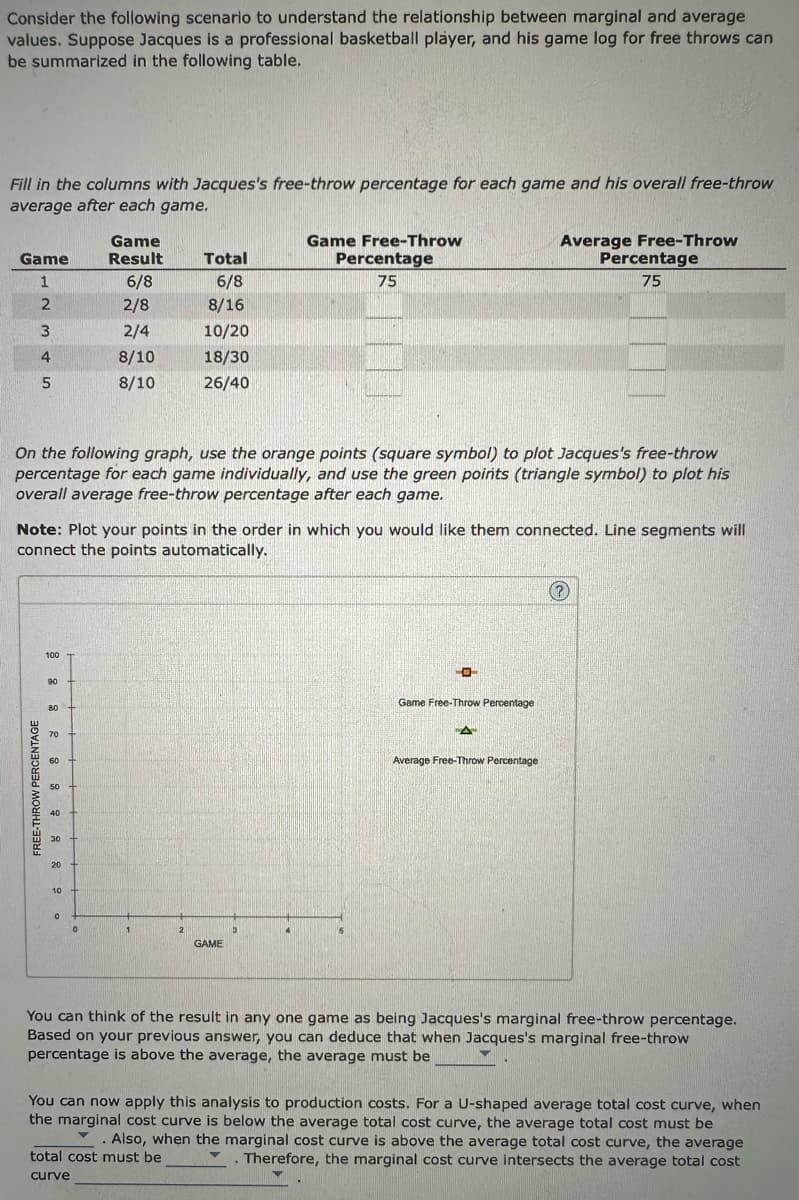Consider the following scenario to understand the relationship between marginal and average values. Suppose Jacques is a professional basketball player, and his game log for free throws can be summarized in the following table. Fill in the columns with Jacques's free-throw percentage for each game and his overall free-throw average after each game. Game 1 2 3 UAU 4 5 FREE-THROW PERCENTAGE 100 90 80 On the following graph, use the orange points (square symbol) to plot Jacques's free-throw percentage for each game individually, and use the green points (triangle symbol) to plot his overall average free-throw percentage after each game. 70 Note: Plot your points in the order in which you would like them connected. Line segments will connect the points automatically. 60 50 40 30 20 10 Game Result 6/8 0 2/8 2/4 0 8/10 8/10 Total 6/8 8/16 10/20 18/30 26/40 1 2 Game Free-Throw Percentage 75 GAME 3 6 O Game Free-Throw Percentage Average Free-Throw Percentage 75 WA Average Free-Throw Percentage (?) You can think of the result in any one game as being Jacques's marginal free-throw percentage. Based on your previous answer, you can deduce that when Jacques's marginal free-throw percentage is above the average, the average must be You can now apply this analysis to production costs. For a U-shaped average total cost curve, when the marginal cost curve is below the average total cost curve, the average total cost must be Also, when the marginal cost curve is above the average total cost curve, the average total cost must be . Therefore, the marginal cost curve intersects the average total cost curve
Consider the following scenario to understand the relationship between marginal and average values. Suppose Jacques is a professional basketball player, and his game log for free throws can be summarized in the following table. Fill in the columns with Jacques's free-throw percentage for each game and his overall free-throw average after each game. Game 1 2 3 UAU 4 5 FREE-THROW PERCENTAGE 100 90 80 On the following graph, use the orange points (square symbol) to plot Jacques's free-throw percentage for each game individually, and use the green points (triangle symbol) to plot his overall average free-throw percentage after each game. 70 Note: Plot your points in the order in which you would like them connected. Line segments will connect the points automatically. 60 50 40 30 20 10 Game Result 6/8 0 2/8 2/4 0 8/10 8/10 Total 6/8 8/16 10/20 18/30 26/40 1 2 Game Free-Throw Percentage 75 GAME 3 6 O Game Free-Throw Percentage Average Free-Throw Percentage 75 WA Average Free-Throw Percentage (?) You can think of the result in any one game as being Jacques's marginal free-throw percentage. Based on your previous answer, you can deduce that when Jacques's marginal free-throw percentage is above the average, the average must be You can now apply this analysis to production costs. For a U-shaped average total cost curve, when the marginal cost curve is below the average total cost curve, the average total cost must be Also, when the marginal cost curve is above the average total cost curve, the average total cost must be . Therefore, the marginal cost curve intersects the average total cost curve
Principles of Microeconomics
7th Edition
ISBN:9781305156050
Author:N. Gregory Mankiw
Publisher:N. Gregory Mankiw
Chapter22: Frontiers Of Microeconomics
Section: Chapter Questions
Problem 6PA
Related questions
Question
Confused on how to solve correctly

Transcribed Image Text:Consider the following scenario to understand the relationship between marginal and average
values. Suppose Jacques is a professional basketball player, and his game log for free throws can
be summarized in the following table.
Fill in the columns with Jacques's free-throw percentage for each game and his overall free-throw
average after each game.
Game
1
2
3
4
5
FREE-THROW PERCENTAGE
22 223 22
100
90
Game
Result
50
6/8
On the following graph, use the orange points (square symbol) to plot Jacques's free-throw
percentage for each game individually, and use the green points (triangle symbol) to plot his
overall average free-throw percentage after each game.
0
2/8
2/4
8/10
8/10
Note: Plot your points in the order in which you would like them connected. Line segments will
connect the points automatically.
Total
6/8
8/16
10/20
18/30
26/40
2
GAME
Game Free-Throw
Percentage
75
9
O
A
Game Free-Throw Percentage
Average Free-Throw
A
Average Free-Throw Percentage
Percentage
75
(?)
You can think of the result in any one game as being Jacques's marginal free-throw percentage.
Based on your previous answer, you can deduce that when Jacques's marginal free-throw
percentage is above the average, the average must be
You can now apply this analysis to production costs. For a U-shaped average total cost curve, when
the marginal cost curve is below the average total cost curve, the average total cost must be
Also, when the marginal cost curve is above the average total cost curve, the average
total cost must be
Therefore, the marginal cost curve intersects the average total cost
curve
Expert Solution
This question has been solved!
Explore an expertly crafted, step-by-step solution for a thorough understanding of key concepts.
This is a popular solution!
Trending now
This is a popular solution!
Step by step
Solved in 4 steps with 1 images

Knowledge Booster
Learn more about
Need a deep-dive on the concept behind this application? Look no further. Learn more about this topic, economics and related others by exploring similar questions and additional content below.Recommended textbooks for you

Principles of Microeconomics
Economics
ISBN:
9781305156050
Author:
N. Gregory Mankiw
Publisher:
Cengage Learning


Principles of Economics 2e
Economics
ISBN:
9781947172364
Author:
Steven A. Greenlaw; David Shapiro
Publisher:
OpenStax

Principles of Microeconomics
Economics
ISBN:
9781305156050
Author:
N. Gregory Mankiw
Publisher:
Cengage Learning


Principles of Economics 2e
Economics
ISBN:
9781947172364
Author:
Steven A. Greenlaw; David Shapiro
Publisher:
OpenStax

Microeconomics: Private and Public Choice (MindTa…
Economics
ISBN:
9781305506893
Author:
James D. Gwartney, Richard L. Stroup, Russell S. Sobel, David A. Macpherson
Publisher:
Cengage Learning